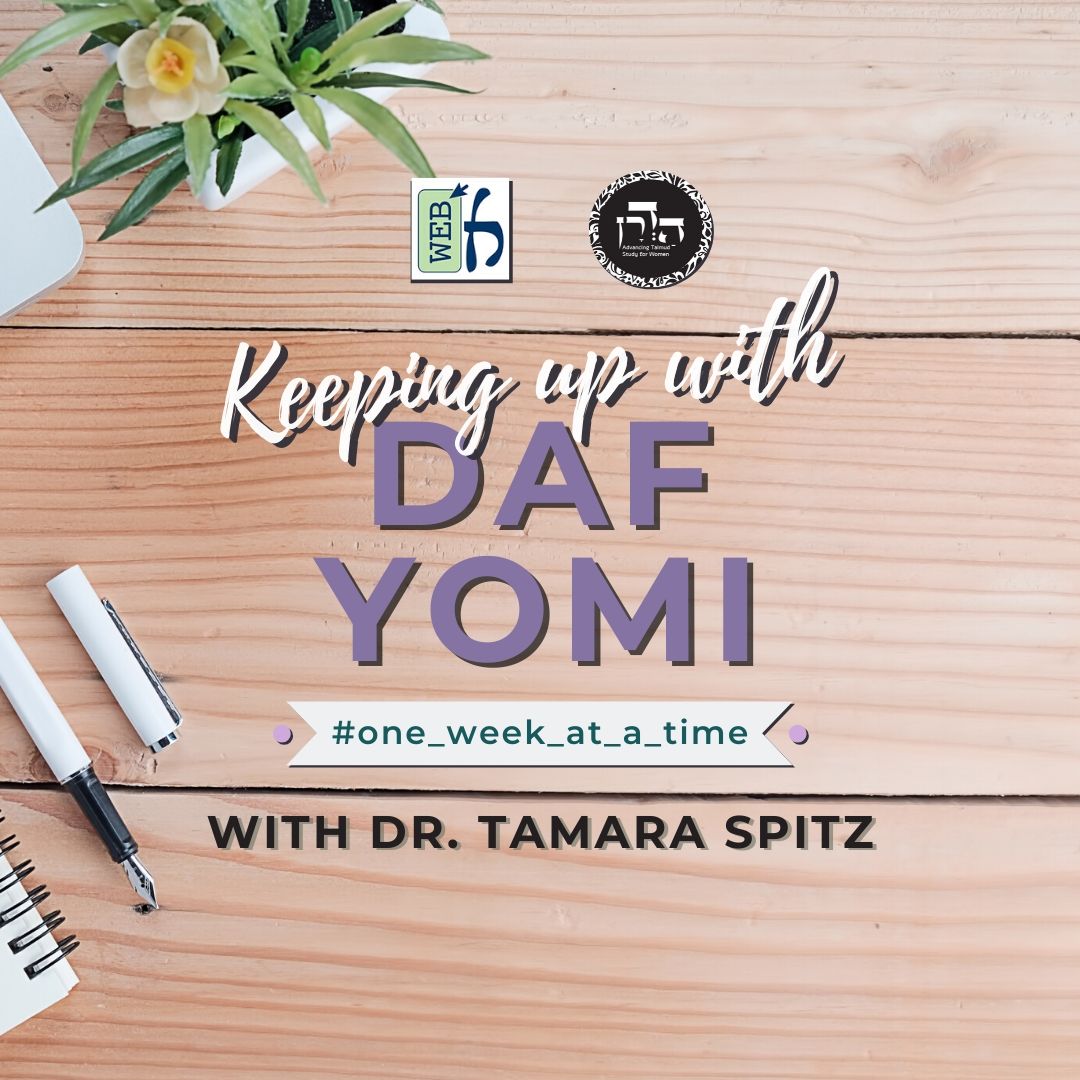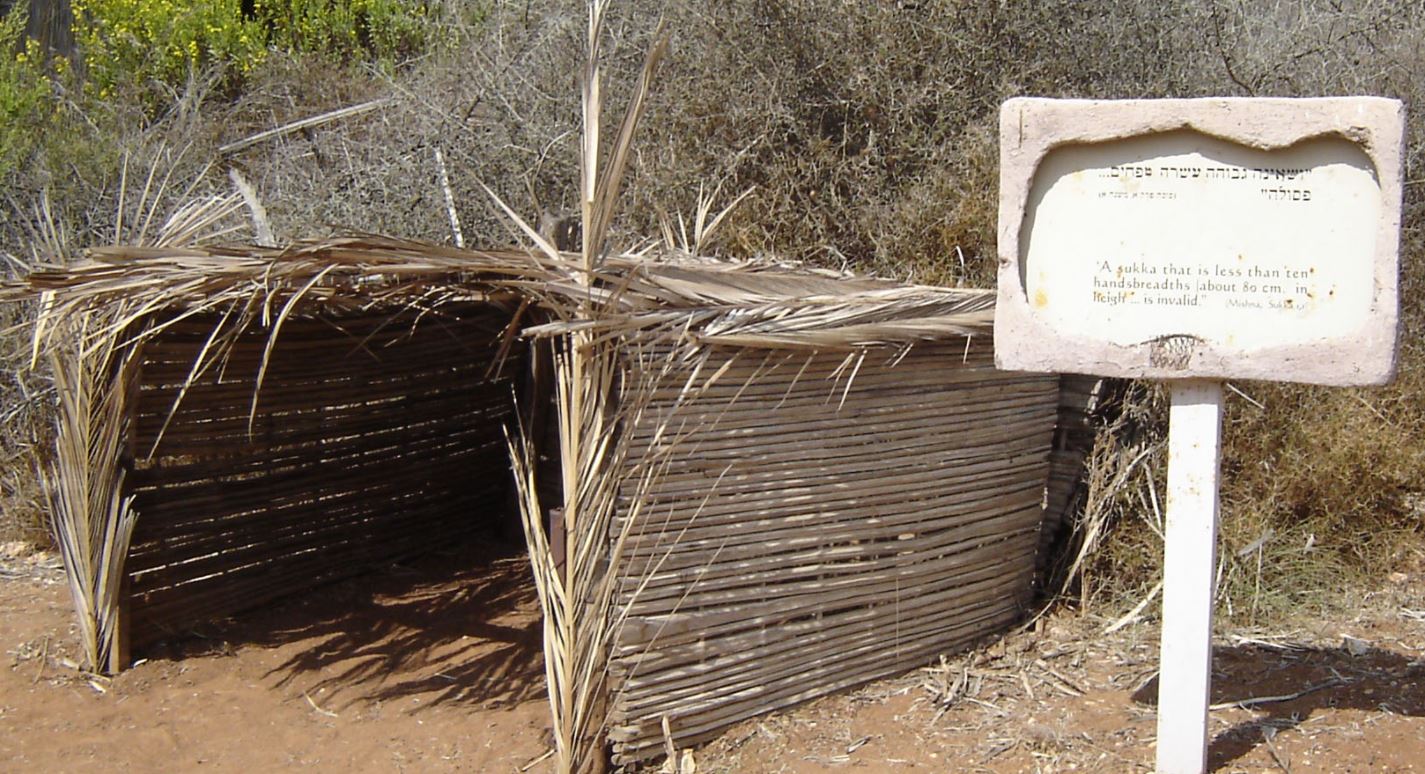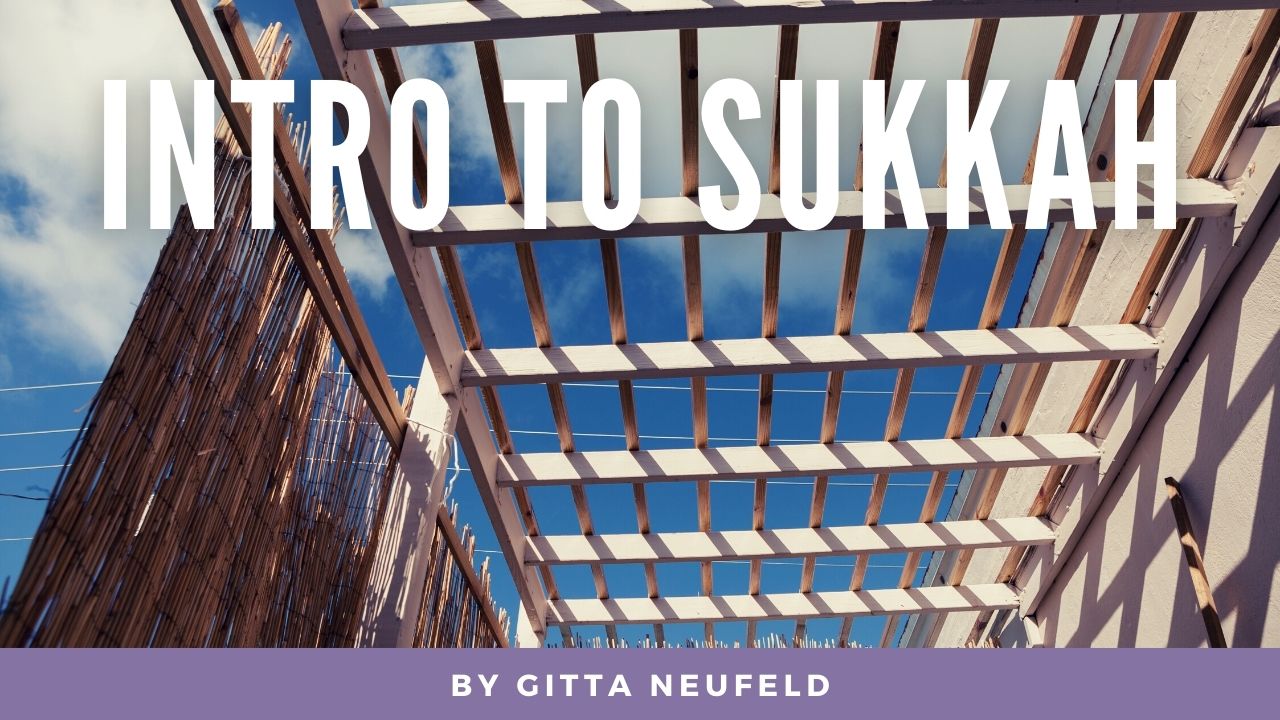Sukkah 2
סוּכָּה שֶׁהִיא גְּבוֹהָה לְמַעְלָה מֵעֶשְׂרִים אַמָּה — פְּסוּלָה. וְרַבִּי יְהוּדָה מַכְשִׁיר.
MISHNA: A sukka, i.e., its roofing, which is the main and most crucial element of the mitzva, that is more than twenty cubits high is unfit. Rabbi Yehuda deems it fit.
וְשֶׁאֵינָהּ גְּבוֹהָה עֲשָׂרָה טְפָחִים, וְשֶׁאֵין לָהּ (שְׁלֹשָׁה) דְּפָנוֹת, וְשֶׁחֲמָתָהּ מְרוּבָּה מְצִלָּתָהּ — פְּסוּלָה.
Similarly, a sukka that is not even ten handbreadths high, and one that does not have three walls, and one whose sunlight that passes through its roofing is greater than its shade are unfit.
גְּמָ׳ תְּנַן הָתָם: מָבוֹי שֶׁהוּא גָּבוֹהַּ מֵעֶשְׂרִים אַמָּה — יְמַעֵט. רַבִּי יְהוּדָה אוֹמֵר: אֵינוֹ צָרִיךְ.
GEMARA: We learned a similar halakha in a mishna there, in tractate Eiruvin (2a): In the case of an alleyway that is higher than twenty cubits, i.e., the beam that was placed across the end of an alleyway that opens into a public domain in order to permit carrying within the alleyway on Shabbat is higher than twenty cubits, one must diminish the height of the beam in order to permit carrying within the alleyway. Rabbi Yehuda says he need not do so, and although the beam lies higher than twenty cubits, the alleyway is qualified to permit carrying within.
מַאי שְׁנָא גַּבֵּי סוּכָּה דְּתָנֵי פְּסוּלָה, וּמַאי שְׁנָא גַּבֵּי מָבוֹי דְּתָנֵי תַּקַּנְתָּא?
Given the seeming similarity between the two cases, that of the sukka and that of the alleyway, the Gemara asks: What is different with regard to a sukka where the mishna teaches that it is unfit, and what is different with regard to an alleyway where the mishna teaches the method of rectification, that one must diminish the height of the cross beam? Why was a solution not suggested in the case of a sukka?
סוּכָּה דְּאוֹרָיְיתָא, תָּנֵי פְּסוּלָה. מָבוֹי דְּרַבָּנַן, תָּנֵי תַּקַּנְתָּא.
The Gemara answers: With regard to sukka, since it is a mitzva by Torah law, the mishna teaches that it is unfit, as, if it is not constructed in the proper manner, no mitzva is fulfilled. However, with regard to an alleyway, where the entire prohibition of carrying is only by rabbinic law, the mishna teaches the method of rectification, as the cross beam comes only to rectify a rabbinic prohibition but does not involve a mitzva by Torah law.
וְאִיבָּעֵית אֵימָא: בִּדְאוֹרָיְיתָא נָמֵי תָּנֵי תַּקַּנְתָּא, מִיהוּ סוּכָּה דִּנְפִישִׁי מִילָּתַהּ — פָּסֵיק וְתָנֵי פְּסוּלָה, מָבוֹי דְּלָא נְפִישׁ מִילֵּיהּ — תָּנֵי תַּקַּנְתָּא.
The Gemara suggests an alternative explanation: And if you wish, say instead that even with regard to matters prohibited by Torah law, it would have been appropriate for the mishna to teach a method of rectification. However, with regard to sukka, whose matters are numerous, it categorically teaches that it is unfit. Merely diminishing the height of a sukka is insufficient to render it fit; the sukka must also satisfy requirements governing its size, its walls, and its roofing. Teaching the remedy for each disqualification would have required lengthy elaboration. With regard to an alleyway, however, whose matters are not numerous, the mishna teaches the method of rectification. Once the height is diminished, it is permitted to carry in the alleyway.
מְנָא הָנֵי מִילֵּי?
§ After clarifying its formulation, the Gemara addresses the halakha in the mishna and asks: From where are these matters, i.e., the halakha that a sukka may not exceed a height of twenty cubits, derived?
אָמַר רַבָּה, דְּאָמַר קְרָא: ״לְמַעַן יֵדְעוּ דוֹרוֹתֵיכֶם כִּי בַסּוּכּוֹת הוֹשַׁבְתִּי אֶת בְּנֵי יִשְׂרָאֵל״, עַד עֶשְׂרִים אַמָּה, אָדָם יוֹדֵעַ שֶׁהוּא דָּר בַּסּוּכָּה, לְמַעְלָה מֵעֶשְׂרִים אַמָּה — אֵין אָדָם יוֹדֵעַ שֶׁדָּר בַּסּוּכָּה, מִשּׁוּם דְּלָא שָׁלְטָא בַּהּ עֵינָא.
Rabba said that it is derived as the verse states: “So that your future generations will know that I caused the children of Israel to reside in sukkot when I took them out of the land of Egypt” (Leviticus 23:43). In a sukka up to twenty cubits high, even without a concerted effort, a person is aware that he is residing in a sukka. His eye catches sight of the roofing, evoking the sukka and its associated mitzvot. However, in a sukka that is more than twenty cubits high, a person is not aware that he is residing in a sukka because his eye does not involuntarily catch sight of the roof, as at that height, without a concerted effort one would not notice the roofing.
רַבִּי זֵירָא אָמַר מֵהָכָא: ״וְסוּכָּה תִּהְיֶה לְצֵל יוֹמָם מֵחוֹרֶב״, עַד עֶשְׂרִים אַמָּה אָדָם יוֹשֵׁב בְּצֵל סוּכָּה, לְמַעְלָה מֵעֶשְׂרִים אַמָּה — אֵין אָדָם יוֹשֵׁב בְּצֵל סוּכָּה אֶלָּא בְּצֵל דְּפָנוֹת.
Rabbi Zeira said that it is derived from here: The verse states: “And there shall be a sukka for shade in the daytime from the heat, and for refuge and cover from storm and from rain” (Isaiah 4:6). In a sukka up to twenty cubits high, a person is sitting in the shade of the sukka, i.e., the shade of the roofing; in a sukka that is more than twenty cubits high, a person is not sitting in the shade of the roofing of the sukka but rather in the shade of the walls of the sukka, as their considerable height provides constant shade, rendering the shade of the roofing irrelevant.
אֲמַר לֵיהּ אַבָּיֵי: אֶלָּא מֵעַתָּה, הָעוֹשֶׂה סוּכָּתוֹ בְּעַשְׁתְּרוֹת קַרְנַיִם, הָכִי נָמֵי דְּלָא הָוֵי סוּכָּה?
Abaye said to him: But if it is so that one is required to sit in the shade of the roofing of the sukka, then in the case of one who makes his sukka in Ashterot Karnayim, which is located between two mountains that prevent sunlight from reaching there, so too, it is not a fit sukka, since he is not sitting in the shade of the roofing.
אֲמַר לֵיהּ: הָתָם, דַּל עַשְׁתְּרוֹת קַרְנַיִם — אִיכָּא צֵל סוּכָּה. הָכָא, דַּל דְּפָנוֹת — לֵיכָּא צֵל סוּכָּה.
Rabbi Zeira said to him: The two cases are not comparable; there, if one theoretically removes the Ashterot Karnayim mountains that obstruct the sunlight, there is still the shade of the roofing of the sukka. In that case, the sukka is properly constructed and there are only external factors that affect the sunlight. However, here, in the case of a sukka that is more than twenty cubits high, if one theoretically removes the walls of the sukka, there is no shade provided by the roofing of the sukka, since throughout the day sunlight will enter the sukka beneath the roofing from where the walls used to be.
וְרָבָא אָמַר, מֵהָכָא: ״בַּסּוּכּוֹת תֵּשְׁבוּ שִׁבְעַת יָמִים״. אָמְרָה תּוֹרָה: כׇּל שִׁבְעַת הַיָּמִים צֵא מִדִּירַת קֶבַע וְשֵׁב בְּדִירַת עֲרַאי. עַד עֶשְׂרִים אַמָּה אָדָם עוֹשֶׂה דִּירָתוֹ דִּירַת עֲרַאי, לְמַעְלָה מֵעֶשְׂרִים אַמָּה — אֵין אָדָם עוֹשֶׂה דִּירָתוֹ דִּירַת עֲרַאי אֶלָּא דִּירַת קֶבַע.
Rava said that the halakha is derived from here: “In sukkot shall you reside seven days” (Leviticus 23:42). The Torah said: For the entire seven days, emerge from the permanent residence in which you reside year round and reside in a temporary residence, the sukka. In constructing a sukka up to twenty cubits high, a person can render his residence a temporary residence, as up to that height one can construct a structure that is not sturdy; however, in constructing a sukka above twenty cubits high, one cannot render his residence a temporary residence; rather, he must construct a sturdy permanent residence, which is unfit for use as a sukka.
אֲמַר לֵיהּ אַבָּיֵי: אֶלָּא מֵעַתָּה, עָשָׂה מְחִיצוֹת שֶׁל בַּרְזֶל וְסִיכֵּךְ עַל גַּבָּן, הָכִי נָמֵי דְּלָא הָוֵי סוּכָּה?
Abaye said to him: But if that is so, then if he constructed a sukka with steel partitions and placed roofing over them, so too, there, say that it would not be a fit sukka, as any sukka constructed as a permanent residence would be unfit. However, there is no opinion that deems a sukka of that sort unfit.
אֲמַר לֵיהּ, הָכִי קָאָמֵינָא לָךְ: עַד עֶשְׂרִים אַמָּה דְּאָדָם עוֹשֶׂה דִּירָתוֹ דִּירַת עֲרַאי, כִּי עָבֵיד לֵיהּ דִּירַת קֶבַע, נָמֵי נָפֵיק. לְמַעְלָה מֵעֶשְׂרִים אַמָּה, דְּאָדָם עוֹשֶׂה דִּירָתוֹ דִּירַת קֶבַע, כִּי עָבֵיד לֵיהּ דִּירַת עֲרַאי, נָמֵי לָא נָפֵיק.
Rava said to him in response that this is what I am saying to you: In a case where one constructs a sukka up to twenty cubits high, a height that a person typically constructs a temporary residence, when he constructs a structure of that height that is sturdy like a permanent residence, he also fulfills his obligation. However, in a case where one constructs a sukka more than twenty cubits high, a height that a person typically constructs a permanent residence, even when he constructs it in a less sturdy fashion like a temporary residence, he does not fulfill his obligation.
כּוּלְּהוּ כְּרַבָּה לָא אָמְרִי, הָהוּא יְדִיעָה לְדוֹרוֹת הִיא.
The Gemara explains why each of the Sages cited his own source and did not accept the sources cited by the others. All of them, Rabbi Zeira and Rava, did not say that the fact that a sukka more than twenty cubits high is unfit is derived from the verse: “So that your future generations will know that I caused the children of Israel to reside in sukkot when I took them out of the land of Egypt” (Leviticus 23:43), as did Rabba, because in their opinion that verse does not mandate one to be aware that he is sitting in a sukka; rather, it mandates knowledge for future generations of the exodus from Egypt.
כְּרַבִּי זֵירָא נָמֵי לָא אָמְרִי, הָהוּא לִימוֹת הַמָּשִׁיחַ הוּא דִּכְתִיב.
Similarly, they, Rabba and Rava, also did not say that it is derived from the verse: “And there shall be a sukka for shade in the daytime from the heat” (Isaiah 4:6), as did Rabbi Zeira, because in their opinion it is with regard to the messianic era that this verse is written. It means that God will be a shield and a shelter for the Jewish people; it is not referring to the structure of a sukka.
וְרַבִּי זֵירָא — אִם כֵּן לֵימָא קְרָא: ״וְחוּפָּה תִּהְיֶה לְצֵל יוֹמָם״, וּמַאי ״וְסוּכָּה תִּהְיֶה לְצֵל יוֹמָם״ — שָׁמְעַתְּ מִינַּהּ תַּרְתֵּי.
The Gemara asks: And Rabbi Zeira, how would he respond to this objection? The Gemara answers that Rabbi Zeira could say: If it is so that the verse is merely a metaphor, let the verse say: And there shall be a canopy for shade in the daytime from the heat, which is the term used in the previous verse. And what is the meaning of: “And there shall be a sukka for shade in the daytime from the heat”? Learn from it two matters: One is the plain meaning of the verse, that God will be a canopy of glory for the Jewish people, and the second is that the essence of a sukka is to have the roofing provide shade.
כְּרָבָא נָמֵי לָא אָמְרִי, מִשּׁוּם קוּשְׁיָא דְאַבָּיֵי.
They, Rabba and Rabbi Zeira, also did not say that it is derived from the verse: “In sukkot shall you reside seven days” (Leviticus 23:42), as did Rava, due to the difficulty raised by Abaye with regard to a sukka with steel partitions. Since there is a weakness in each of the sources, it is understandable why the other Sages did not accept it.
כְּמַאן אָזְלָא הָא דְּאָמַר רַבִּי יֹאשִׁיָּה אָמַר רַב: מַחְלוֹקֶת בְּשֶׁאֵין דְּפָנוֹת מַגִּיעוֹת לַסְּכָךְ, אֲבָל דְּפָנוֹת מַגִּיעוֹת לַסְּכָךְ — אֲפִילּוּ לְמַעְלָה מֵעֶשְׂרִים אַמָּה כְּשֵׁרָה. כְּמַאן?
§ The Gemara asks: In accordance with whose opinion is that which Rabbi Yoshiya said that Rav said: The dispute between Rabbi Yehuda and the Rabbis with regard to the fitness of a sukka more than twenty cubits high is specifically in a case where the walls of the sukka do not reach up to the roofing; however, in a case where the walls of the sukka reach up to the roofing, the Rabbis concede that even if the roofing is more than twenty cubits high, it is fit. In accordance with whose opinion is it?
כְּרַבָּה, דְּאָמַר מִשּׁוּם דְּלָא שָׁלְטָא בַּהּ עֵינָא, וְכֵיוָן דִּדְפָנוֹת מַגִּיעוֹת לַסְּכָךְ, מִשְׁלָט שָׁלְטָא בַּהּ עֵינָא.
It is in accordance with the opinion of Rabba, who says that the reason that a sukka that high is unfit is because the eye does not automatically catch sight of the roofing. And since the walls of the sukka reach the roofing, the eye catches sight of the roofing, as the person will follow the walls all the way up to the roofing despite their considerable height. However, if the roofing is not contiguous with the top of the walls, a person does not notice it without a concerted effort.
כְּמַאן אָזְלָא הָא דְּאָמַר רַב הוּנָא אָמַר רַב: מַחְלוֹקֶת בְּשֶׁאֵין בָּהּ אֶלָּא אַרְבַּע אַמּוֹת עַל אַרְבַּע אַמּוֹת, אֲבָל יֵשׁ בָּהּ יוֹתֵר מֵאַרְבַּע אַמּוֹת עַל אַרְבַּע אַמּוֹת — אֲפִילּוּ לְמַעְלָה מֵעֶשְׂרִים אַמָּה כְּשֵׁרָה. כְּמַאן?
The Gemara asks: In accordance with whose opinion is that which Rav Huna said that Rav said: The dispute between Rabbi Yehuda and the Rabbis with regard to the fitness of a sukka more than twenty cubits high is specifically in a case where there is not an area of four cubits by four cubits in the sukka; however, in a case where there is an area of more than four cubits by four cubits in the sukka, the Rabbis concede that even if the roofing is more than twenty cubits high, it is fit. In accordance with whose opinion is it?
כְּרַבִּי זֵירָא, דְּאָמַר: מִשּׁוּם צֵל הוּא, וְכֵיוָן דִּרְוִיחָא — אִיכָּא צֵל סוּכָּה.
It is in accordance with the opinion of Rabbi Zeira, who says that a sukka that high is unfit due to the shade that is provided by the walls and not by the roofing; and since the sukka in this case is spacious and has a large area, there is shade from the roofing of the sukka and not only from the walls.
כְּמַאן אָזְלָא הָא דְּאָמַר רַב חָנָן בַּר רַבָּה אָמַר רַב: מַחְלוֹקֶת בְּשֶׁאֵינָהּ מַחְזֶקֶת אֶלָּא כְּדֵי רֹאשׁוֹ וְרוּבּוֹ וְשׁוּלְחָנוֹ, אֲבָל מַחְזֶקֶת יוֹתֵר מִכְּדֵי רֹאשׁוֹ וְרוּבּוֹ וְשׁוּלְחָנוֹ — אֲפִילּוּ לְמַעְלָה מֵעֶשְׂרִים אַמָּה כְּשֵׁרָה. כְּמַאן — דְּלָא כְּחַד.
The Gemara asks: In accordance with whose opinion is that which Rav Ḥanan bar Rabba said that Rav said: The dispute between Rabbi Yehuda and the Rabbis with regard to the fitness of a sukka more than twenty cubits high is specifically in a case where the sukka is only large enough to hold one’s head, most of his body, and his table, as, if the sukka were smaller, it would not qualify as a sukka; however, in a case where it is sufficiently large to hold more than one’s head, most of his body, and his table, even if it is more than twenty cubits high, it is fit. In accordance with whose opinion is it? It is not in accordance with the opinion of any one of them. This statement cannot be explained according to any of the rationales for the fact that a sukka more than twenty cubits high is unfit.
בִּשְׁלָמָא דְּרַבִּי יֹאשִׁיָּה פְּלִיגָא אַדְּרַב הוּנָא וְרַב חָנָן בַּר רַבָּה, דְּאִינְהוּ קָא יָהֲבִי שִׁעוּרָא בִּמְשָׁכָא, וְאִיהוּ לָא קָא יָהֵיב שִׁעוּרָא בִּמְשָׁכָא.
With regard to the three aforementioned halakhot, the Gemara notes: Granted, the statement of Rabbi Yoshiya differs from the statements of Rav Huna and Rav Ḥanan bar Rabba, as they are providing the measure of the extent of the sukka while he is not providing a measure. In Rabbi Yoshiya’s opinion, the halakha is based on whether the top of the walls reach the roofing, which indicates a fundamentally different understanding of the issue of a sukka more than twenty cubits high.
אֶלָּא רַב הוּנָא וְרַב חָנָן בַּר רַבָּה, נֵימָא בְּהֶכְשֵׁר סוּכָּה קָמִיפַּלְגִי, דְּמָר סָבַר הֶכְשֵׁר סוּכָּה בְּאַרְבַּע אַמּוֹת, וּמָר סָבַר הֶכְשֵׁר סוּכָּה בְּמַחְזֶקֶת רֹאשׁוֹ וְרוּבּוֹ וְשׁוּלְחָנוֹ?
However, in terms of Rav Huna and Rav Ḥanan bar Rabba, let us say that it is with regard to the minimum size required for fitness of a sukka that they disagree; as one Sage, Rav Huna, holds: The minimum size required for fitness of a sukka is four by four cubits, and the other Sage, Rav Ḥanan bar Rabba, holds: The minimum size required for fitness of a sukka is one that holds one’s head, and most of his body, and his table.
לָא, דְּכוּלֵּי עָלְמָא הֶכְשֵׁר סוּכָּה רֹאשׁוֹ וְרוּבּוֹ וְשׁוּלְחָנוֹ. וְהָכָא בְּהָא קָמִיפַּלְגִי: דְּמָר סָבַר בְּמַחְזֶקֶת רֹאשׁוֹ וְרוּבּוֹ וְשׁוּלְחָנוֹ פְּלִיגִי, אֲבָל יוֹתֵר מֵרֹאשׁוֹ וְרוּבּוֹ וְשׁוּלְחָנוֹ — דִּבְרֵי הַכֹּל כְּשֵׁרָה,
The Gemara rejects this suggestion: No, there is no need to explain their dispute that way, as it could be explained that everyone, i.e., Rav Huna and Rav Ḥanan bar Rabba, agrees that the minimum size required for fitness of a sukka is one that holds one’s head, and most of his body, and his table. And here, it is with regard to this that they disagree: One Sage, Rav Ḥanan bar Rabba, holds that Rabbi Yehuda and the Rabbis disagree only with regard to a sukka more than twenty cubits high in a case where it holds the person’s head, and most of his body, and his table. However, in a case where it is larger than one that holds one’s head, and most of his body, and his table, everyone agrees that the sukka is fit regardless of its height.
וּמָר סָבַר מֵרֹאשׁוֹ וְרוּבּוֹ וְשׁוּלְחָנוֹ עַד אַרְבַּע אַמּוֹת פְּלִיגִי, אֲבָל יוֹתֵר מֵאַרְבַּע אַמּוֹת — דִּבְרֵי הַכֹּל כְּשֵׁרָה.
And one Sage, Rav Huna, holds that it is with regard to a sukka that ranges in size from one that holds one’s head, and most of his body, and his table up to one that is four by four cubits that they disagree; however, if the sukka is more than four by four cubits, everyone agrees that it is fit.
מֵיתִיבִי: סוּכָּה שֶׁהִיא גְּבוֹהָה לְמַעְלָה מֵעֶשְׂרִים אַמָּה — פְּסוּלָה, וְרַבִּי יְהוּדָה מַכְשִׁיר עַד אַרְבָּעִים וַחֲמִשִּׁים אַמָּה.
The Gemara raises an objection from a baraita: A sukka that is more than twenty cubits high is unfit. Rabbi Yehuda deems a sukka fit even if it is up to forty or fifty cubits high.
אָמַר רַבִּי יְהוּדָה: מַעֲשֶׂה בְּהֵילֶנִי הַמַּלְכָּה בְּלוֹד שֶׁהָיְתָה סוּכָּתָהּ גְּבוֹהָה מֵעֶשְׂרִים אַמָּה, וְהָיוּ זְקֵנִים נִכְנָסִין וְיוֹצְאִין לְשָׁם וְלֹא אָמְרוּ לָהּ דָּבָר. אָמְרוּ לוֹ: מִשָּׁם רְאָיָיה? אִשָּׁה הָיְתָה וּפְטוּרָה מִן הַסּוּכָּה. אָמַר לָהֶן: וַהֲלֹא שִׁבְעָה בָּנִים הֲווֹ לָהּ, וְעוֹד: כׇּל מַעֲשֶׂיהָ לֹא עָשְׂתָה אֶלָּא עַל פִּי חֲכָמִים.
Rabbi Yehuda said: There was an incident involving Queen Helene in Lod where her sukka was more than twenty cubits high, and the Elders were entering and exiting the sukka and did not say anything to her about the sukka not being fit.
The Rabbis said to him: Is there proof from there? She was, after all, a woman and therefore exempt from the mitzva of sukka. Consequently, the fact that her sukka was not fit did not warrant a comment from the Elders.
Rabbi Yehuda said to them in response: Didn’t she have seven sons and therefore require a fit sukka? And furthermore, she performed all of her actions only in accordance with the directives of the Sages.
לְמָה לִי לְמִיתְנֵי ״וְעוֹד כׇּל מַעֲשֶׂיהָ לֹא עָשְׂתָה אֶלָּא עַל פִּי חֲכָמִים״?
Before analyzing the objection being raised from the baraita, the Gemara seeks to understand its content. Why do I need Rabbi Yehuda to teach: And furthermore, she performed all of her actions only in accordance with the directives of the Sages? His first contention was sufficient.
הָכִי קָאָמַר לְהוּ: כִּי תֹּאמְרוּ בָּנִים קְטַנִּים הָיוּ, וּקְטַנִּים פְּטוּרִין מִן הַסּוּכָּה — כֵּיוָן דְּשִׁבְעָה הֲווֹ, אִי אֶפְשָׁר דְּלָא הָוֵי בְּהוּ חַד שֶׁאֵינוֹ צָרִיךְ לְאִמּוֹ.
The Gemara answers that this is what Rabbi Yehuda is saying to them: If you say that Helene’s sons were minor sons and minors are exempt from the mitzva of sukka, and that is why the Elders said nothing; since they were seven sons, then it is not possible that there was not at least one among them who no longer needed his mother to look after him. The halakha is that a minor who no longer needs his mother has reached the age of training and is required to fulfill the mitzva of sukka by rabbinic law. Even if she gave birth to them in consecutive years, the oldest would be seven years old, and at that age a child does not need his mother to constantly look after him.
וְכִי תֵּימְרוּ קָטָן שֶׁאֵינוֹ צָרִיךְ לְאִמּוֹ מִדְּרַבָּנַן הוּא דְּמִיחַיַּיב, וְאִיהִי בִּדְרַבָּנַן לָא מַשְׁגְּחָה, תָּא שְׁמַע: וְעוֹד, כׇּל מַעֲשֶׂיהָ לֹא עָשְׂתָה אֶלָּא עַל פִּי חֲכָמִים.
And if you say that a child who no longer needs his mother is obligated in the mitzva of sukka only by rabbinic law, and Queen Helene did not observe rabbinic law, come and hear that which Rabbi Yehuda said: And furthermore, she performed all of her actions only in accordance with the directives of the Sages.
בִּשְׁלָמָא לְמַאן דְּאָמַר בְּשֶׁאֵין דְּפָנוֹת מַגִּיעוֹת לַסְּכָךְ מַחְלוֹקֶת, דַּרְכָּהּ שֶׁל מַלְכָּה לֵישֵׁב בְּסוּכָּה שֶׁאֵין דְּפָנוֹת מַגִּיעוֹת לַסְּכָךְ,
The Gemara explores the statements of the amora’im who quoted Rav in light of this baraita. Granted, according to the one, Rabbi Yoshiya, who said that it is specifically in a case where the walls of the sukka do not reach up to the roofing that there is a dispute between Rabbi Yehuda and the Rabbis, the baraita can be explained as dealing with a sukka of that type, as it is customary for a queen to reside in a sukka in which the walls do not reach up to the roofing,


























